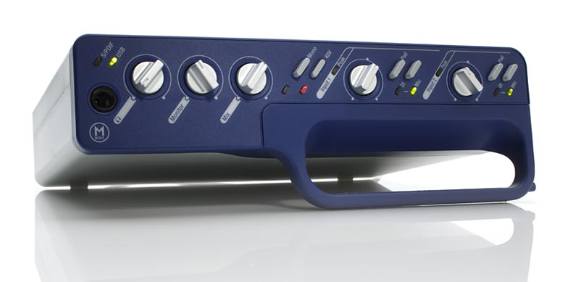Digidesign has unveiled the sequel to what has been its most popular interface:
Mbox 2 [Digidesign]
What’s new: In brief, same basic I/O plus new MIDI in and out, slick, new case, and huge software bundle. Still only two simultaneous ins, though, not including the digital ins. More after the jump.

The Mbox 2’s most noticeable feature is the new case, with a clever handle that doubles as a stand. As a handle, doesn’t seem terribly useful, unless you lack opposable thumbs or lost all your fingers in a guitar-playing accident, but it does look nice. (I can’t tell if it folds away for travel.) Aesthetics overall are greatly improved; it had been part of the popularity of the original Mbox, and Mbox 2 looks smarter and more practical. And, finally, you can lie the Mbox on its side.
Other than looks, the major change in Mbox 2 is the addition of MIDI in and out (finally), something many of Mbox’s cheaper rivals have standard. Sure, there are lots of USB devices out there — but I bet you have something in your studio that doesn’t have MIDI.

Also impressive is the software bundle, which includes Pro Tools LE, lots of plugins, and limited copies of Live, Reason, the BFD drum library, soft synths and effects, and other extras. Just keep in mind that, other than Pro Tools LE and some very nice Digidesign plugins, most of what you’re getting isn’t full versions.
Price:List US$495. Spend another US$100 for Mbox 2 Factory (you’ll want to) and you get Maxim (the maximizer effect, not the lousy men’s magazine), moogerfooger Analog Delay, JOEMEEK Compressor and Meequalizer, and Cosmonaut Voice. Yeah, I’ll take the Super Size model, please.
2 ins only: Despite the fact that the press release claims “4 simultaneous inputs,” that’s assuming two of the inputs are S/PDIF digital. If you’re looking for four simultaneous mic ins at once, the Mbox isn’t what you’re looking for. Also, there’s no indication that Digidesign has updated its driver support, which on the Mac requires the use of a separate application for use with Core Audio drivers. Neither of these is a deal-killer if you’re just tracking a line or two of vocals into your laptop and you spend all of your time in Pro Tools, but as always, one size won’t fit all.
Bottom line: this interface certainly wins out on aesthetics of the small interfaces, and it’s a no-brainer for Pro Tools lovers. But, as with previous Mbox models, you’ll probably want to look elsewhere if you’re not a Pro Tools fan — non-Pro Tools driver support is still better on non-Digidesign interfaces (including M-Audio’s).
Want more inputs? There are plenty of interfaces that do support multiple ins.